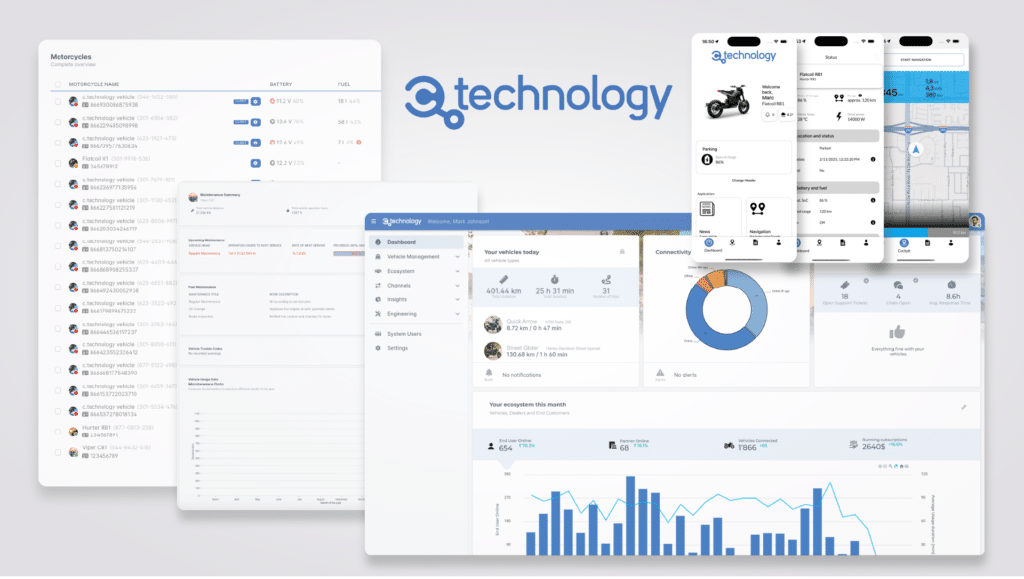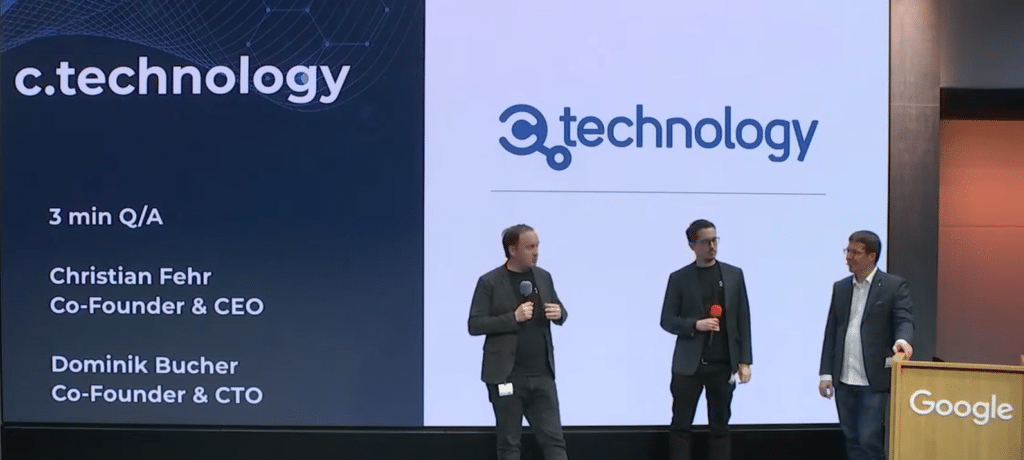Industry Leader Speaks About Transforming Vehicle Data into Valuable Digital Services
c.technology is a leading provider of digital solutions for powersports, micro-mobility and boating. The company’s mission is to set new standards for connected vehicles, enabling OEMs, dealers, and vehicle owners to interact – both with each other and with their vehicles – through an AI-based vehicle cloud and white-label front-end solutions.
By transforming vehicle data into valuable digital services, c.technology helps manufacturers enhance customer experiences, improve operational efficiency, and unlock new revenue streams across their entire ecosystem. The modular, plug-and-play approach ensures that OEMs, both large and small, stay ahead in an increasingly connected and digitalized world.
EVinfo.net had the great pleasure and honor of speaking with Dominik Bucher PhD, Co-Founder & CTO at c.technology.

Bill Pierce:
Can you tell us a bit about your background and what led you to focus on vehicle connectivity and digital solutions?
Dominik Bucher:
I started out in electrical engineering, studying at ETH Zurich, UC Berkeley, and the University of Edinburgh, and later earned a PhD in Geoinformatics at ETH Zurich, where I focused on mobility data analysis and sustainable transportation. Over the years, I worked at various companies and co-founded a few startups, always drawn to innovation and problem-solving.
When the c.technology co-founding team initially met, we quickly saw a huge gap in digitalization within the powersports, micro-mobility and boating industries (boats, two-wheelers, utility vehicles, etc.). These sectors were far behind in connectivity and smart solutions. That’s what led us to start c.technology—to bring modern digital tools to these industries and make them more connected, efficient, and future-ready.
Bill Pierce:
What excites you the most about the solution your team provides?
Dominik Bucher:
What excites me most is how simple and effective our solution is for powersports manufacturers of all sizes. We take care of everything—connectivity, data storage, analysis, management, and even building applications for their end customers—so they can focus on what they do best: manufacturing great vehicles.
Our modular architecture makes it incredibly fast to bring connected vehicles to market, while ensuring real-time data processing, scalability, and security. Plus, we don’t just handle the raw data—we turn it into beautiful, intuitive applications that add real value. Seeing manufacturers go from offline to fully digital with ease is what drives us every day.

Bill Pierce:
The boating and powersports industries have been slower to adopt digitalization compared to automotive and other sectors. What are the key factors driving the shift towards connected solutions now?
Dominik Bucher:
I think this shift is driven by several key factors: First, customer expectations have changed—people are used to the benefits of connectivity from the automotive world and now expect the same for their boats, motorcycles, and specialized vehicles.
Second, manufacturers are realizing the advantages of connectivity, from better fleet management and predictive maintenance to improved customer support, security, and even new revenue opportunities. And third, digitalization is no longer just for high-end vehicles—affordable IoT hardware and cloud solutions have made it possible to bring connectivity to smaller, more cost-sensitive vehicles like scooters and entry-level powersports models. This means that even manufacturers of lower-priced vehicles can now offer smart features that were once reserved for premium segments.
That said, the industry is still in its early stages, and c.technology is leading the way as a first mover, bringing these innovations to a market that’s just beginning to unlock the full potential of connectivity.
Bill Pierce:
What are the biggest challenges that OEMs and fleet operators face when implementing connectivity solutions, and how does your platform help address them?
Dominik Bucher:
From what we see, many lack in-house expertise, as building and maintaining a connected platform requires specialized skills. Coming from hardware manufacturing, their development cycles are rigid and pre-planned, leaving little flexibility for dedicated software teams. Cost is another major factor—developing a custom solution and hiring the right talent is expensive and resource-intensive.
Our platform solves these challenges by providing a specialized, secure, and scalable connectivity solution that integrates seamlessly. Because we focus exclusively on cloud connectivity, we offer a cost-effective, ready-to-deploy solution that allows manufacturers to quickly outfit a single product line or digitize their entire portfolio—without disrupting existing operations.
Bill Pierce:
So the platform is solely focused on connectivity and digitalization, which includes vehicle monitoring and management?
Dominik Bucher:
Yes, our core focus is connectivity and digitalization through a cloud-based solution, which naturally includes vehicle monitoring and management. However, we go beyond simple tracking—we integrate the entire vehicle ecosystem, connecting the “triangle” of OEM, professional partners, and end customers to create real value from this network.
Beyond connectivity, our platform provides specialized tools for different stakeholders, including marketers, analysts, engineers, operators, and sales teams. Features improving customer outreach, market insights, firmware management, and operational tools make it more than just a monitoring solution—it’s a comprehensive digital platform for managing connected vehicles efficiently. At the same time, our analytics help OEMs and fleet operators meet sustainability regulations, providing insights on emissions, energy use, and environmental impact—helping businesses stay compliant while optimizing efficiency.
Bill Pierce:
c.technology provides a hardware-agnostic, scalable platform for vehicle OEMs. Can you explain how this differentiates you from other market players?
Dominik Bucher:
Many market players come from an IoT hardware background, meaning their solutions are tightly linked to their own devices—if you don’t use their hardware, their platform isn’t an option. Others take a very generic approach, offering only basic building blocks for digital twin platforms, or they focus on narrow use cases like fleet management or specific operational components.
In contrast, we provide a true backbone for OEM connectivity—fully hardware-agnostic, scalable, and built for deep integration. Our real-time APIs allow seamless connections with existing systems, our out-of-the-box applications provide immediate value, and our SaaS-based model ensures that OEMs can not only digitize their vehicles but also monetize the value they create. This flexibility and depth set us apart from both hardware-locked and existing generic solutions.
Bill Pierce:
Your platform consists of OEM dashboards, dealer access, and white-label mobile apps for vehicle owners. How do these elements work together to create value for the entire ecosystem and all parties involved?
Dominik Bucher:
Each part of our platform is designed to serve its primary user: OEMs get powerful data and fleet management tools, dealers gain direct customer access and maintenance insights, and vehicle owners enjoy 24/7 connectivity with a digital logbook and real-time insights—improving enjoyment and security.
However, a lot of value gets unlocked by how these elements work together: dealers can proactively assist owners, notify them when maintenance is due, or escalate issues to the OEM. OEMs gain real-time insights into vehicle usage, segmented across owner groups, allowing them to improve products and offer additional digital services. Owners benefit from seamless support, direct access to maintenance manuals via our AI assistant, and an overall better ownership experience. All of this operates within a privacy-first, regulation-compliant framework, ensuring that data is shared securely and only where it enhances functionality and creates real value.
Bill Pierce:
What role does monetization play in your offering? Can you share examples of how OEMs or partners have tailored your solution to their business needs?
Dominik Bucher:
Monetization is a core aspect of our offering—not just as an add-on, but as a way for OEMs to actively participate in the value created through digitalization. Our goal isn’t just to provide the best out-of-the-box connectivity solution, but to ensure that OEMs and their partners benefit directly and monetarily from the digital ecosystem we help them build.
This collaborative approach means OEMs can tailor monetization to their business needs. For example, they can offer one-time feature unlocks, such as purchasing an additional battery, or introduce premium subscriptions, like advanced motorcycle navigation or nautical maps for boaters. On a professional level, specialized solutions for shipyards, rental operators, or fleet managers may be unlocked, and their revenue shared between involved parties. This flexible monetization model ensures that digitalization isn’t just an operational upgrade, but a sustainable revenue stream for OEMs.
Bill Pierce:
Do you believe that current maritime and powersports markets, especially electric, stagnation could be partially overcome by connectivity solutions? How do connected solutions create new revenue opportunities for vehicle manufacturers and their partners as well as additional value for the vehicle owners?
Dominik Bucher:
At its core, powersports is about vehicles, and thus about getting from A to B. While leisurely activities are occasionally in the focus, light two-wheelers, especially electric ones, are increasingly being used for commuting—offering a space-saving, sustainable, and efficient alternative to cars. This overall demand isn’t slowing down; in fact, electrification and rising global prosperity are likely to accelerate it.
However, competition is intensifying as globalization and lower development costs make it easier for new players to enter the market. To stay competitive, OEMs must differentiate through new features and services—connectivity is a proven way to do this. From home automation to automotive, digital solutions have created immense value, and vehicles are no exception. Connected features not only enhance the user experience but also streamline maintenance, improve brand loyalty, and unlock new revenue streams. Many consumers nowadays expect seamless convenience on par with service-based ownership models, making digital integration both a competitive advantage and a business necessity.
Bill Pierce:
Can you talk about how real-time vehicle data and predictive maintenance features improve customer experience and reduce costs?
Dominik Bucher:
Let’s look at the value of real-time data first: Owners always have instant access to key information like location, state of charge or fuel levels, charging history, and even automated charge planning. This improves convenience, security—think theft protection or simply peace of mind—and safety—for example, by enabling users to track friends or family during rides.
On the maintenance side, immediate diagnostics ensure that necessary actions are taken on time, reducing wear and preventing costly breakdowns. Integrated maintenance manuals provide step-by-step guidance, while seamless OEM and dealer connectivity streamlines service requests and support. A digital maintenance logbook not only simplifies servicing but also increases resale value, as buyers can verify the vehicle’s history. For dealerships, pre-diagnosed issues reduce unnecessary checks, making repairs more efficient and cost-effective.
Bill Pierce:
Data privacy and security are major concerns for OEMs and end customers. How does your platform ensure secure data transmission and storage?
Dominik Bucher:
We ensure secure data transmission and storage by leveraging the latest cloud and database technologies along with widely adopted IoT and web standards—the same principles used in banking and governmental IT services. This guarantees end-to-end protection, both in transit and at rest, while allowing controlled data sharing between OEMs, professionals, and owners through a granular, potentially time-restricted, access framework.
Additionally, we collaborate with leading experts in cloud architecture, security, and compliance, ensuring that our platform meets the highest standards for privacy, data processing, and regulatory requirements (including regulatory frameworks and standards like GDPR and the EU Data Act). This proactive approach keeps our solution not only secure but also aligned with evolving legal and industry standards.
Bill Pierce:
Would you say that connectivity in the powersports and boating industries is becoming a trend, a necessity, or is it still just ‘a cool thing to have?
Dominik Bucher:
Connectivity in the powersports and boating industries is undergoing a disruptive shift—moving from a “nice-to-have” feature to an essential, expected standard. We’re in a transition phase where connectivity is becoming a “hygiene factor”, something that buyers, dealers, and maintainers simply expect as part of any modern vehicle.
At the same time, it retains its excitement—there’s still something undeniably satisfying about reliving a trip by following the route taken, once you’re home. This shift isn’t just about practicality; it’s about enhancing the entire ownership and riding experience in a way that’s both functional and engaging.
Bill Pierce:
Where do you see the biggest growth opportunities in vehicle connectivity over the next five years?
Dominik Bucher:
Connectivity is the key enabler of full digitalization. In the future, every vehicle will have a complete digital representation, allowing owners to focus entirely on what they love—traveling, commuting, or customizing their vehicles—while an intelligent (eco)system handles the rest.
Over the next five years, the biggest growth opportunities will come from advancements in IoT networks, deeper integration of IoT hardware with vehicle control units, and specialized cloud solutions like the one by c.technology. As IoT networks expand and connectivity costs drop, we’ll see mass adoption across all vehicle segments.
Electric vehicles, which benefit from faster time to market due to fewer mechanical components, will further accelerate this shift. Additionally, light two-wheelers—such as scooters, e-bikes, and small motorcycles—are booming for both commuting and leisure, particularly in densely populated urban areas. Emerging markets in India, Southeast Asia, Africa, and South America represent major growth frontiers, as affordable, connected mobility solutions become increasingly accessible. Soon, no vehicle will be produced without some form of internet connectivity, making digital services and automation a fundamental part of modern mobility.
Bill Pierce:
Are there any emerging technologies (e.g., AI, IoT. etc) that you believe will play a crucial role in shaping the next generation of boating and powersports digital services?
Dominik Bucher:
Software-defined vehicles are set to reshape the powersports industry, just as they are in automotive. Manufacturers are already developing flexible vehicle platforms that can be customized through modular components and software, making feature unlocks as simple as a software switch. This shift will allow for greater personalization, over-the-air updates, and new business models based on digital services.
And let’s not forget the current, groundbreaking advances in AI: Our AI “talk to your vehicle” assistant already showcases the potential of this technology—and we’re just getting started. Soon, vehicle owners won’t need to look up what a warning light means, plan routes manually, or dig through menus for settings. Instead, they’ll simply talk to their vehicle, which will understand their needs and proactively assist. The combination of AI, IoT, and cloud connectivity will make powersports vehicles smarter, more intuitive, and more enjoyable than ever before.

Bill Pierce:
How does c.technology plan to evolve in response to market trends and customer needs?
Dominik Bucher:
Our primary goal is to create real value for OEMs, professionals, and vehicle owners. We stay closely connected with industry players worldwide—OEMs, dealers, and end users—to continuously listen, learn, and adapt to their needs.
At the same time, we are committed to pushing the boundaries of what’s technologically possible, while ensuring stability and longevity in our core systems. Our team consists of world-class specialists in software and vehicle connectivity, with PhD-level expertise from renowned universities and leading companies. As the market evolves, we will continue to lead innovation, ensuring that our platform remains cutting-edge, reliable, and future-proof.
Bill Pierce:
What advice would you give to OEMs that are still hesitant about adopting connected solutions?
Dominik Bucher:
To be frank—just reach out to us for a quick demonstration! We can integrate our solution directly into an OEM’s vehicles, giving them a real-world picture of what connectivity can do. Thanks to ongoing innovation—c.technology’s included—connectivity is now easier and more affordable than ever.
More broadly, most OEMs already know that connectivity is inevitable—it’s just a matter of when to make the move. My advice? Appoint someone to seriously explore connectivity, identify what’s most important for your business—whether it’s an end-user app, dealer support tools, operational insights, or vehicle management—and build a business case around it. Once that’s clear, let’s talk—we’ll help turn that vision into reality.
Bill Pierce:
How can interested OEMs or industry stakeholders learn more about your platform and engage with your team?
Dominik Bucher:
OEMs and industry stakeholders interested in learning more about our platform should visit https://ctechnology.io, where they’ll find an introduction to our solutions, real-world use cases, and customer success stories.
More importantly, we encourage direct engagement—our team is always open to talk about vehicle connectivity and digitalization. Simply use the form on https://connect.ctechnology.io/contact-us: companies can connect with us directly, and for those who prefer a hands-on approach, we also offer a fully functional online demo of the platform. We are committed to understanding industry needs and developing innovative, valuable solutions, working closely with OEMs and partners to drive the future of connected powersports.

Electric Vehicle Marketing Consultant, Writer and Editor. Publisher EVinfo.net.
Services